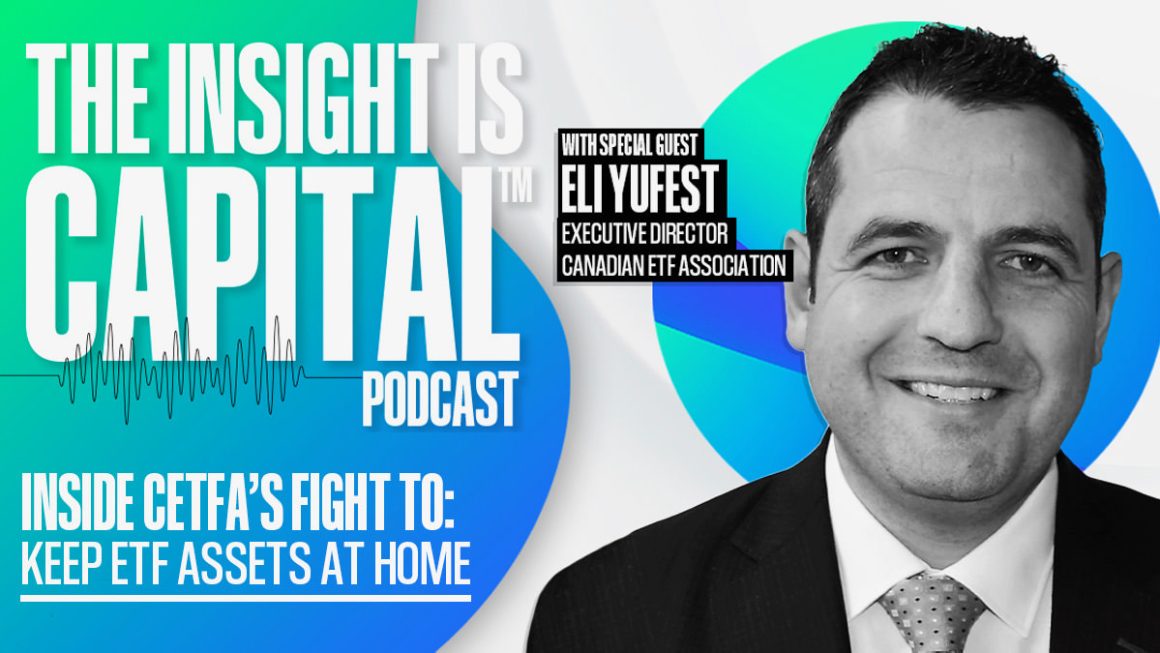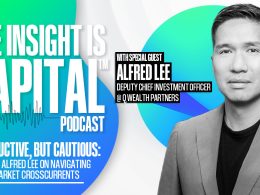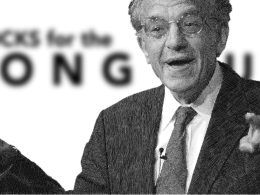Eli Yufest: [00:00:00] $230-billion Canadian dollars from Canadians has flowed into the US and entered the US ecosystem. And so what does that mean? That means no issuers are the benefit of that, flow. No indexes are the benefit of that flow. No capital markets, no lawyers, no auditors, no regulators, no taxes, nobody.
All of that money has left and it’s probably left for good. It’s gonna be very hard to repatriate that money. But, we’re gonna work, we’re gonna work on some things to try to bring it back, but it’s gonna be very challenging. Okay. So over a third, the size of our industry has left Canada and has gone to the U.S.
Announcement: This is Insight is Capital. Join us in our fireside chats with some of the most fascinating people in finance to discuss their insights on life markets, macro investment strategy, and much more.
Pierre Daillie: Welcome back. This is Insight Is Capital. I’m Pierre Daillie, Managing Editor [00:01:00] at AdvisorAnalyst.com. The Canadian ETF industry continues to experience rapid expansion in 2025 with assets under management, nearing $600 billion and projections for continued double digit growth, fueled by strong inflows, evolving investor preferences, and increasing adoption by both institutional and retail investors, seeking flexible, cost effective and diversified solutions.
Eli Yufest, executive director at CETFA. The Canadian ETF Association is my guest. Eli was appointed executive director of CETFA earlier this year. Prior to that, he’s had an extensive career as CEO and partner of a national marketing research and consulting firm, where among other things, he worked on the campaigns of political candidates, including the former mayor of Toronto and Premier of Ontario.
In addition to that, he has served as a principal at Canada’s top communications and public affairs firm, where he advised Fortune 500 clients, among others on [00:02:00] their most pressing, strategic and organizational issues. Eli, I. Wow. It’s, fantastic to have you on the show. Welcome.
Eli Yufest: Thank you very much, Pierre, for having me.
I’m really happy to, be here with you today.
Pierre Daillie: Likewise. Eli, just let’s jump in. let’s start at the beginning. Tell us, a bit about your career journey. What’s the story behind your career and what inspired you ultimately this year to get involved in reshaping the Canadian ETF landscape?
Eli Yufest: thanks very much Pierre, for the introduction.
Frankly, I don’t know if I’ll be able to top what you just did, but I’ll try my best. yeah, I’ve, got over 20 years of experience, working in, what I described broadly as marketing strategy, data analytics. I. I’ve had the good fortune of working. I guess if I can describe it into two sides of, of the industry, so what I call the consulting side.
I’ve spent half my career as, you alluded to, in the consulting world, working, across numerous [00:03:00] verticals, whether it’s, politics, public affairs, consumer packaged goods, travel and tourism, financial services, et cetera, et cetera. And I spent the other half of my career. If you will, working on what’s called, the buyer side.
So I spent, five years, managing, the insights department at Whirlpool Canada. And I spent, just, just over four years, working at Johnson and Johnson, in brand management. And so when I look back at my career, all told, I’ve, had the good fortune, if you will, of have having a pretty diverse set of experiences, working with some amazing clients, some amazing organizations.
And I’ll just say one more thing very quickly. Over the last five or so years, I think it’s about five and a half years, I’m actually also a part-time professor at, a number of universities and colleges across, the province. It’s been one of, frankly speaking, one of the most, interesting, rewarding, jobs that I’ve been fortunate to have.
I love meeting students. I love teaching. I love exploring ideas. and, [00:04:00] and over the last 20, or I guess it’s now 22 years. If I had to summarize all of my experiences, that’s the way I would classify them all.
Pierre Daillie: Amazing. it’s, you’ve had quite a breadth of experience across many different areas and then.
On top of that, like where do you find the time to also be a part-time professor? That’s incredible.
Eli Yufest: Yeah. it takes a village. I’ve got, a very understanding wife, so thank you very much, Jen, for, helping me. very involved family. Of course, my, my mother-in-law, it really does take a village and, and I’m very fortunate to have that village to help, to help you know, me with my career and, I’ve got three kids, which is probably the most important job that I have.
And yeah, I, somehow make it work with, the village that supports me.
Pierre Daillie: Yeah. Eli, that’s, that’s inspiring. That’s, amazing. to have been able to pack that much, that much activity into your, working life and career, [00:05:00] it must bring a really. incredible dimension to whatever you’re doing.
to have so many, mental models and, experiences that inform
Eli Yufest: your thought. Yeah, I think, I think just the benefit of my interesting and what, I call interesting, unique experience because typically. And maybe I’m being a bit, a bit, general here, most people, once they pick a career path, they go down that career path.
if you’re an accountant, you’re an accountant, if you’re a lawyer, you’re a lawyer. If you work in financial services, you work in financial services. And I’ve, gone back and forth between consulting, buyer side teaching, and I’ve had to get fortune of working across numerous industries.
And to your point, I, bring all that experience to bear into what I’m currently, doing right now at the, at the ETF Association.
Pierre Daillie: I’m just thinking that, in terms of, your last five years, you mentioned that, you’ve been a part-time professor at several colleges and universities.
I, I can’t help thinking that [00:06:00] must also really help to inform your perspective on that generation.
Eli Yufest: absolutely. students, I. and what’s interesting, about the educational landscape right now is, as you might be familiar, or some of your viewers might be familiar, we, Canada has had the benefit, I would say, largely the benefit of, many international students coming to the country over the last number of years.
And so many of my classes are comprised of many Canadians, of course, but also a large contingent of, of, international students. And so it’s interesting to see. The dynamic between both of these sort of student groups working together, the benefits that go along with exchanging of ideas.
and I can say just very, very specifically, the students, irrespective of whether they’re international or Canadian, are hungry. They wanna learn. They, they want a career. They all want a house. They all want, they all want a normal life and they’re, hungry to achieve it.
And so it’s been interesting. To experience that and to help them in that journey as they, [00:07:00] go from students to, to, to productive workers and Canadians.
Pierre Daillie: It must be very gratifying. Dis all. Yeah, absolutely. Yeah. So Eli, you’re fairly new face in the ETF world now that you’ve had some time to settle in, what has surprised you, have there been any aha moments since stepping into your role?
Eli Yufest: I would say there’s probably two. Interesting things that, you know, prior to getting into the role, I, never really thought the industry would be like it. The first one is just how dynamic and how innovative, ETFs are. I never really gave as much thought, frankly, before I got into the role, but now that I’m in the role, I can look at all of the things, about the industry and say, this is probably one of the most dynamic industries that I’ve ever worked in.
And I’ve worked in just about every, industry, every vertical, out there. just for a bit of context, you would, of course, know this, ETFs were invented in Canada. They were Canadian pension 35 years ago. And so you look at all of the things [00:08:00] that the industry has done over the last 35 years, and all the innovation covered calls, crypto.
ESG thematics, all of this stuff really comes out of Canada. And Canada is a thought leader, is a trailblazer on, on, on many of these technologies and, many of these, aspects of the industry. And so I had no idea, frankly, before I got into the role that ETFs were created in Canada, crypto started in Canada, et cetera, et cetera.
Yeah, so that’s one interesting aspect for me. that was probably the biggest aha moment is. Just how dynamic and how, innovative the industry is in Canada. And, that’s our gift, if you will, to the world, right? we, we are thought leaders in this space, and now we’re, spreading, the technology and the innovation, globally.
the other thing is, and this is, this has been, particularly interesting for me given my political and public affairs background, is just how, willing participants, the regulators and the politicians have been to listen to us. [00:09:00] we have great relationships with many regulators, across the country.
We have standing meetings with them. We have standing discussions with them. the association is now, in a more meaningful, relevant way, increasing our advocacy efforts with, with politicians, with elected officials, their staff members, the bureaucracy. And they’re very willing to listen to us.
They’re very will willing to take a meeting with us. And that was the sort of the other aha moment for me is just how. Interested. The other side of the coin is, in, in, in speaking with us, because they’re looking for ideas. They’re looking for a stakeholder. They’re looking for, a partner that can, give them context and perspective about the industry.
And, we’re, we’ll very happily, fill that, role for them.
Pierre Daillie: I don’t think people, I don’t think the folks in the industry fully understand what CETFA is all about and what it has. what? The work of CETFA is the complication of what CETFA does. I mean, what CETFA is [00:10:00] trying to bridge in terms of linking the industry, between regulators and like the, it’s a very, the pathways are very complicated, very bureaucratic in some cases between securities regulators.
The issuers, the industry itself, which is why there’s so much input from, the board if we can shed some light on what CETFA actually does, as opposed to have it be something that, that might by the participants, by the, the advisors in the business. Even investors don’t realize what you do, right?
you represent nearly the entire ETF industry in Canada. you are playing a huge role in education and advocacy, and as the ETF space grows, Eli and, diversifies, how do you see your mission at CETFA adapting?
Eli Yufest: Our mission is very, simple and it’s to grow the industry. And I’m, perhaps I’m oversimplifying it from [00:11:00] what, what can be found on our website, but it’s really just to grow the industry.
And we, we look at, what the penetration rate is of ETFs right now. And the number that, I often cite is, 20%. So 20% of Canadians invest in ETFs. I. and you know what I told my board and, what I tell, other stakeholders is that if we want to continue to grow the industry, if we want to go from 20 to 25% to 30%, et cetera, et cetera, penetration, the only way to do that is to, to your point, I.
Work with the regulators, work with the politicians to make sure that we have the environment in which we can grow the industry. So to go from 20% penetration to 25 to 30. So we need the regulators and the politicians as a key partner, a willing participant to help us, break down the barriers that will enable us to grow the industry.
So that’s point number one and point number two, we have to do a better job of educating a couple of key stakeholders. What I call Jane and Joe [00:12:00] front Porch investor. These are just average Canadians, that aren’t currently investing in ETFs. They might, not even know what an ETF is, right?
they might not even know what it stands for. They might not even know how to access it. They might not know the basics of what an ETF is. You
Pierre Daillie: have to literally start from square one, right? Yeah,
Eli Yufest: right, exactly. And working with the regulators is one aspect, the other side is working with Jane and Joe for On Porch.
I have to explain to them the benefits of an ETF. What an ETF is, why they should consider investing in an ETF and probably. Why they might wanna consider removing some money from other investments like mutual funds into ETFs. And as of, July 1st, or the beginning of July, I should say, maybe, the, the partners that I’m working with might, get angry with me that I’m, I’ve given it a very specific date of July 1st, but in early July, we’re actually undertaking, a totally revamped digital and social media campaign around innovation.
and its focus will be. Targeted towards Jane and Joe Front Porch Investor, the [00:13:00] retail investor, and explaining to them all of these things that you know, that, that you and I are talking about. So that’s gonna be one, one key, element of something that the association’s gonna be working on, not just into, through the balance of 2025, but certainly into 2026 and 2027 and beyond.
The other key stakeholder is working with advisors. Most flow still goes through advisors. in fact, a strong majority of flow still flows through advisors and so we need to also work with advisors on educating them on why they might wanna. Suggest ETFs to their clients, how ETFs even work, frankly speaking, and I’ll just give you a very simple example.
I was at a conference, about a month or so ago of advisors, and we asked the question, I, how many advisors work with ETFs? Sell ETFs, recommend ETFs. There’s a room of about 300, people, only five went up. So we have a large. Wow. Job. Yeah. That was, that, that, was quite shocking to me as well.
Yeah. Yeah. Maybe I’m wrong. Maybe it was seven ends, [00:14:00] but, it, it was, a, it was, definitely a minority. Yeah. It was, a overwhelming minority. Yeah. So I took that as a, as a, key takeaway. And I said, okay, we have to also include advisors as part of our, as part of our outreach, and as part of our, as, part of our education, mandates that, the association is undertaking.
And so again, in early July in. Concert with or running parallel with the education and the campaigns that we’re gonna be running towards Jane and Joe, front Porch investor. We’re gonna be targeting advisors specifically around the merits and the benefits, of, ETFs and why they might want to include that as part of their recommendation to their clients.
And all three of these stakeholders, whether it’s regulators, whether it’s investors, whether it’s advisors, are gonna be a key focus for us, not just this year, like I said, but but in the coming years for sure.
Pierre Daillie: Yeah. So with education, such a major part of your mandate, what do you think are some of the biggest, [00:15:00] biggest misconceptions or knowledge gaps out there right now among Canadian investors and advisors, when it comes to ETFs?
Like what have you revealed? What have, what’s been revealed to you and, how is CETFA going to help close
Eli Yufest: those gaps? So I just alluded, about a minute or two ago around the education campaign. So part of the, social, media and digital campaign that we’re gonna be undertaking in the next, week or so is around things like, what is an ETF?
like I said, if 20% of companies are investing in an ETF, I’m going to assume that a strong majority of the remaining 80% of Canadians don’t even know the basics of what an ETF is. Right? And we need to explain to them, that they’re exchange traded, they’re very liquid. They don’t just, they’re not just bought and sold at the end of the day, like, other investment tools.
So very liquid. Very accessible. and you can, purchase them through some online brokerage channel or through an advisor. [00:16:00] and they’re very, easily, accessible. So just the basics. A around right around. So that’s one, one component around, education that we’re gonna be hammering quite a bit in the coming, in, the coming weeks and months.
The other, side of that is costs, I think. There’s this perception out there, even, among some regulators and, what I call sort of the political class, if you will, that ETFs, are or have the same sort of cost structure built into them as a mutual fund. And of course that’s not true.
they’re generally lower cost, they’re generally smaller margin for, for, issuers. And Explaining to them that there are lower management’s fees typically associated with an ETF versus other investment options is something else, that we’re gonna be focusing on quite a bit.
Because if I’m Jane and Joe front porch and I’m investing in a mutual fund, I would probably ask the person who was telling me I. To invest in et ef f why would I invest in [00:17:00] etf? My money’s parked in a mutual fund or something else. And, I’m, very happy with the returns. And so we’re gonna be speaking to about, we’re gonna be speaking about costs.
and I think there’s a lot of misconceptions around costs. And the regulators have done a good job now breaking down some of the barriers around costs with some of the new rules that are coming out, or that have come out. And that will come out in, 2026. So
Pierre Daillie: that’s another, yeah, there are CRM, CRM3 and.
We’ve had CRM2 already, but CRM3 promises to, lift the lid on
Eli Yufest: everything. exactly. Exactly. which, which, I think, is, by and large a good thing. We wanna democratize information. Yeah. We want to democratize products, we wanna, give more information to, investors.
And that’s, all forthcoming, but that’ll be also incumbent upon the association to help educate. And, get that message out there. The other, side of that is, 35 years ago, there was just passive ETFs, let’s call it. And I, alluded to the evolution of all of these things, [00:18:00] over the last 35 years, and I.
that’s gonna be another sort of aspect of education that we need to focus on. it’s not just passive, it’s not just, active. It’s, a whole suite of, amazing technologies that are largely born in Canada, like crypto, for example. I. That, that, investors will have, will have access to.
And so these are just three components of a very broad sort of educational campaign that we’re gonna be weaving in through a lot of our social media, and digital, marketing that we’re gonna be undertaking, like I said, in a couple weeks.
Pierre Daillie: Amazing. I, think, starting from, the very beginning makes sense in terms of reaching the widest number of.
People, Jane and Joe Front Porch, Jane and Joe Front porch. what do you like, I’m just curious, what do you, hear from, for example, your students about, I I, think Gen Z is very [00:19:00] interested in investing, but from your, do you have conversations with your students about. some of the things you’re doing now with CETFA
Eli Yufest: Yes.
Is that I don’t get too much into the investment side of it, of course, because I’m not licensed and regulated and I can’t give, legal advice, but not advice. Yeah. what’s, so I, do ask my students, how many invest in mutual funds? How many invest in etf?
How many, what sorts of investments are they making? And what’s interesting is, in this, this is kind of part of the narrative of ETFs. ETFs are perhaps a little bit more technologically sophisticated than other types of, investment vehicles. DIY is of course increasing.
Who’s more likely to use a DIY tool? It’s younger people. Younger people are better with technology. And just empirically when I speak to the students, they’re more inclined to use online brokerages. They’re more inclined to right, to, to manage things, on their own. and this is just one, one interesting example has nothing to do with students.
I was at the gym [00:20:00] the other day working out and I saw what, two young people, they could have very likely been my students. They were, I, wouldn’t think older than 22 or 25 years old. And they were literally talking about ETFs, buying gold ETFs, buying crypto ETFs, doing it through an online brokerage.
And when. Two guys working out at a gym are talking around the interesting technology and the interesting ways to access ETFs. we’re the industry’s onto something and so then it’s, that’s our part to, to elevate that discussion and blow that discussion up and now bring it beyond, what might be an inclined demographic, namely young people.
And now, bring it, to, bring it to the masses of Canadians.
Pierre Daillie: from your vantage point. What are some of the most pressing challenges the ETF industry in Canada’s facing or dealing with right now?
Eli Yufest: You started off our conversation, Pierre, by talking about the 600, billion a [00:21:00] and, you’re, a hundred percent right with that.
The other side of that coin that you didn’t mention, and this is I think, the biggest issue that we’re facing, because it touches on so many things in, in, in the industry, is. 230 billion based on some analysis that one of my members, have done, is, suggesting that money has flowed out of the ecosystem and it’s gone directly to the United States.
So if our industry is worth 600 billion in Canada, 230 billion, I. Canadian dollars from Canadians has flowed into the US and entered the US ecosystem. And so what does that mean? That means, yeah, no issuers are the benefit of that, flow. No indexes are the benefit of that flow. No capital markets, no lawyers, no auditors, no regulators, no taxes, nobody.
All of that money has left and it’s probably left for good. It’s gonna be very hard to repatriate that money. but we’re gonna work, we’re gonna work on some things to try to bring it back, but [00:22:00] it’s, gonna be very challenging. Okay. Sorry. Over a third, the size of our industry has left Canada and has, gone to the us
Pierre Daillie: So that, is that 230 billion, is that part of the 600 billion That’s in, that’s not, it’s on top of, that’s totally, separate.
Yeah,
Eli Yufest: totally separate. Okay. you juxtapose, or I guess you look at also, the. expiration on the Vanguard patent in 2023. I, see you nodding. So you’re, familiar with it. we are now also familiar or we’re aware of 60, 60, issuers in the US that have applied for, license to sell, ETF, share class, and the SEC is, I think, gonna be ruling on it imminently.
Like we’re, expecting an answer in the, at some point this summer. So just back of, the napkin Math 60 issuers, they issued 20 ETFs. we’re looking at, if my math is right, [00:23:00] 1200 potentially new products that Canadians are gonna have access to, which they’ve never had access to.
Canadians were never able to access American Mutual funds. They were able to access right American ETFs, but not mutual funds. And so now this will open up. What I’m describing as a floodgate at a tsunami, quite literally, I don’t want to under to
Pierre Daillie: US mutual funds
Eli Yufest: right through the US Yeah.
through this ETF share class. And 1200 and 1200 is a conservative estimate. So we, are fully expecting that if 230 billion is left, the Canadian marketplace, once Canadians have access to, these 1200 conservative, 1200 new, ETFs. That’s just going to increase the flow.
And so based on this analysis, at some point, maybe even, towards the end of my lifetime, it’s probably not in my lifetime, but towards the end of my lifetime, but certainly my kids’ lifetime, if this trajectory continues, there really won’t be a. an ETF ecosystem in Canada, this is this is how [00:24:00] stark we see the issue is.
And we’re gonna be working with regulators, we’re gonna be working with politicians, to address this issue. And we, we think the timing is actually right. There’s a lot of noise coming outta the US of course, around, tariffs and taxes and so that’s one aspect that, we think actually might benefit our advocacy efforts.
The other side of that is of course, we have a new Prime Minister who has a financial services and banking background. probably better, he probably better understands the financial services landscape. of, recent memory for sure. and yeah, I would expect so. Yeah, he, and, you look at who he’s, who some of his top advisors are.
There are, they’re by and large bankers, or, or professional business people who understand the nature of business. And so in the recent election, we were talking about breaking down into provincial trade barriers. We were talking about, focusing [00:25:00] on Canada, we were talking about.
He’s brought in a, an amazing team, prime Minister Karn. He’s brought in an amazing team of, people who understand the business. We have noise coming outta the US and so if I can describe it as a, perfect, storm of sorts that we now see things as an opportunity. We see, that if we advocate for the industry, if we change some of the.
Tax structures are ran. If we reduce the, burdens, on, the industry, we will be as competitive or more competitive to the US. And Canadians will not choose to send their money to the us not to put, to find a point on it. Capital finds the path of lease resistance and frankly speaking, the path of lease resistance is the US.
So that’s why we’re seeing a lot of money flow to the us, not just from Canada, but yeah, I’m, concerned about Canada, but money flows from all over the world. And so my objective, is to take all of these issues and engage [00:26:00] with the federal government, the provincial governments. Let’s break down these provincial trade barriers.
Let’s make our, our system as efficient or more efficient as the American. A system so that Canadians and others invest in the Canadian Financial Services and ETF ecosystem so that we can be the benefit of the jobs, the investment, the tax revenue, et cetera, that goes along with all that money.
Pierre Daillie: Looking at, for example, the idea that investors are choosing to invest in US listed ETFs over. versus investing in the Canadian equivalent, the Canadian domicile. The equivalence, when they can, the problem is that. We’ve taken it for granted. we can invest in US stocks whenever we like, when you can invest in US ETFs whenever we like.
We can’t invest in US listed mutual funds. But, if that’s, something that’s about to change, but Americans are not, are, not able to, nor are they [00:27:00] trying to invest in our market, in any sort of meaningful way. Yeah. And I see what you’re doing at CETFA is also to sustain. Industry. It’s to make sure that, Canadians understand that, when you go to buy that ETF in the us, make, why don’t you take a look first to see if there’s the exact same one listed in Canada.
Yep. And in most cases, a lot of these, a lot of the Canadian domicile ETFs. Are, providing US dollar options or Canadian dollar options, but domestically, so you don’t have to deal with that foreign property rules. You’re not gonna have to deal with section 8, 9, 9. Yeah. You’re not gonna have to deal with all these other problems that are on the horizon.
and, you’re gonna contribute meaningfully by doing that to the assets staying in Canada.
Eli Yufest: Agreed, agreed. I guess a couple points. The latest. I don’t know if there are actually rumors anymore. There were rumors I think yesterday, but the latest that I’ve heard, ’cause the Global [00:28:00] Mail and Bloomberg were reporting on it, is that section 8, 9 9, the punitive side on the, I, think you called the pier, the revenge tax.
I think has actually been removed. That’s, that, that’s the latest, which is I think, good news. That’s remarkable. Yeah. Yeah. if, the rumors, if the articles, that have been published turn out to be true, I think that’s a good thing. so that’s, the, that’s, wonderful that, thank you for sharing that.
Yeah. The second point, is, look, the association as I mentioned, is. Know, cares about, the future of the industry. Forget about ETFs for a second, but financial services. And so the question that we’re gonna,
Pierre Daillie: Eli, you are the Canadian ETI association. It’s not, it’s just Yes, I agree.
It’s not just the E TF association, it’s the Canadian ETF Association of, course. Yeah. It’s very
Eli Yufest: important. And so, the politic, the question that we’re gonna be asking, the politicians and, our political leaders is, do we want a financial services? Do we want an ETF?
Market in Canada, and I [00:29:00] presume the que the answer to that will be, yes, of course. Why wouldn’t we? Yeah. if that is in fact the will of the regulators, and it is in fact the will of the politicians and, I know it is because, that’s what they’re telling us, then they’ll be able to find a, willing partner with us to give them ideas around how to make, the.
the ETF ecosystem more competitive in the us. And just one more point I can say, I can tell you that I’ve spoken to many counterparts, what I call, si, sister, organizations from adjacent financial services associations, and they have the same sentiment.
And so I think, frankly speaking, I’m six months into the role, but I don’t think I’m misspeaking when I say for the first time in. Canadian financial services history. We have, almost near alignments from, all of the associations, all of the, the entirety of the financial services ecosystem.
We’re, [00:30:00] all aligned on the objective of making sure that we have a, of a, of, a, we have a sustainable financial services ecosystem that Canadians will wanna invest in. We’re engaging with policy leaders and politicians and their staff to ensure that message. is loud and clear and what we’re giving them ideas on how to achieve that.
And I while I can’t speak on behalf of other associations, I can say I’m speaking to my counterparts at other associations. we’re in alignment in this regard. And I can say specifically, CETFA will be undertaking, like I said, some, advocacy work to drive this point home.
We’re gonna be engaging with politicians, with their staff, with the bureaucracy, with, ideas on how to make our system more competitive.
Pierre Daillie: let’s, stop beating ourselves up. Let’s stop beating each other up, and let’s stop looking over the fence and thinking the gr the grass is greener next door.
Agreed. I think, if we are gonna, if we’re gonna have a, self-supporting as much as it’s [00:31:00] possible, a self-supporting capital market, one of the most interesting things that, that’s been tossed around lately in the last, in like during the last, two or three months at least. Was the launch of, private equity ETFs, priv.
And then I know, it came up in a recent podcast that you were on and it was, it’s been, it’s come up in several podcasts that we’ve done, episodes where we’ve, talked about, the launch of, private equity in an ETF wrap. perhaps the most interesting thing about that, other than the fact that it’s somewhat controversial at this point, right?
not for long, but the most interesting thing that came up about that was that then it was, the conversation we had with Dave Natig. and what he brought up was the fact that, the most surprising thing about those was not just that they’re controversial, but that the amount of capital.
That those instruments attracted [00:32:00] because they were in an ETF wrapper. They were able to, they were able to attract capital, much more efficiently and much more rapidly and in a much more, in a much more liquid fashion. Or, they were much more liquid friendly to investors than the typical private equity vehicles that have been in existence forever.
Yep. And what that, point was, that if we’re going to have a capital market where people have a chance to participate in a democratized version of capital markets through the ETF wrapper, chances are they will. Yeah. and that’s what we’re seeing in the US on, on, on those innovations.
those were standout things that, that got dis, that got a lot of discussion. but looking at, the, how the ETF wrapper makes it [00:33:00] possible for will, can, will make it possible for Canadian investors to invest in Canadian capital markets more easily, more directly, as opposed to it being strictly the domain of, ultra high net worth or right institutional investors.
You’re opening up to a, whole new world of opportunity of investing for,
Eli Yufest: for Canadians. Agreed. Agreed. Like I, I don’t have any data to back this up, but if you were to ask me if I wanted to invest in some private equity deal, I wouldn’t even know the first step about how to do that. I could probably figure it out.
Oh, yeah. But I, but, I think most investors probably wouldn’t even know how to do that. So the ETF wrapper enables people literally at the snap of fingers to to, gain access to some of these things that would be otherwise. Largely unreachable unless you’re a high, ultra high net worth or institutional best.
the technology that is ETF has democratized, [00:34:00] investment tools for literally anybody. if you have a couple of dollars, extra dollars and you wanna invest in an ETF, all you need to do is just open up your smartphone, download, some DIY brokerage go to, go to an advisor.
It’s really just that simple and it’ll take a few seconds to do. if I, like I said, if you ask me, Hey Eli, why don’t you invest in some private equity deal? I wouldn’t know the first app. How? Yeah. I wouldn’t know how. yeah, I mean that, that’s being part of the problem, right? The part like, how do I invest in managed futures?
Pierre Daillie: How do I invest in, in, long, short equity. How do I invest in, typically, up until maybe, just maybe two or three years ago that was ims, that unless you were ultra wealthy right, or you were an institution that was next to impossible to do, you had to go through all the accredit accredited investor rules.
You had to qualify, you had to do all that Now. You’re gonna, we’re I, we’re starting to see, all these different types of, hedge fund strategies, absolute [00:35:00] return strategies being wrapped in ETFs that now make diversification at the institutional grade. I. of diversification where you can actually start to introduce more esoteric strategies, more uncorrelated strategies into your portfolio.
it’s a very exciting time to be an advisor. It’s a very exciting time to be an investor. I agree. Thanks to ETFs. I,
Eli Yufest: I agree a hundred percent. Yeah.
Pierre Daillie: You’re, known, at set F for bringing together leaders in the ETF space and collaborating with regulators. There are a number of very, broad and imposing.
Regulations on the horizon for 2026 CM three. can you a among others and can you give a few recent examples of how CETFA have helped shape policy or helped elevate best practices across the industry?
Eli Yufest: Yeah, my, my board and all the committees that I have at SFR basically represent, to your point, Pierre, the entirety of the industry.
[00:36:00] We have 96%, of, a represented, by, the association. And I have because of that, the good fortune of working with literally the best and brightest people in the industry. And they’re reflected in my board. They’re reflected on, my committees. And so anytime an issue comes up, we look at it internally and we decide, okay, is this a policy issue, a tax issue?
whatever it is, do we need, to form a new. A new committee to look at it, address it, and, devise a strategy or plan to, address it. And we, have standing meetings with the OSE, for example, as just, every quarter we meet, we have a regular cadence of, discussion with them.
If we need something ad hoc, they would be there of course, as well, where we talk about all the issues, that are present to us now and that we expect, might be. might be an issue. And we, we’ve [00:37:00] got a, good cadence of, meetings with them. They’re very receptive, like I’ve mentioned a number of times to, meeting with us.
We’ve done the same thing, in Quebec right now with a MF. We’ve recently just engaged them. we, prior to, me joining prior to this year, we had actually never engaged the A MF, in any, meaningful way. Wow. and we just started an engagement process with the A MF, the Quebec, ministry of Finance.
We’ve, we’ve met with officials there. Like I said, we’re working on a number of things federally. We’re gonna be undertaking literally in the next couple weeks, a very significant, adv advocacy campaign to, make Canadians want to invest in Canada. That’s actually, I. What the committee that we was called Invest in Canada Committee.
And so it’s aptly named because that’s, our objective. It’s to, enable, Canadians to invest in Canada. And without get getting into the specifics of, what we’re working on and what we’re talking about with some of the regulators and the politicians, I can say that we’re having meaningful [00:38:00] conversations with Ontario regulators, Ontario politicians, Quebec politicians, Quebec regulators, federal politicians, upcoming, f federal regulators.
It’s just part of our sort of refocused effort on advocacy. We wanna be a stakeholder, that the regulators and the governments want to call when they want to do something to optimize the ecosystem. And, what happens when we’re not at the table? the, BCSE last year came up with a new, fee increase.
We were not at the table, and that, that passed. And, now we’re bearing the repercussions of, that, of that fee hike. And With me coming on board over the last six months. I’ve said to my board, we need to be more engaged, more relevant.
We need to engage the state, the regulators and the politicians in a more meaningful way than we’ve ever done, to prevent, things like what happened in British Columbia, la from occurring, right? And to make sure that if. A [00:39:00] regulator. if, the politicians wants to develop a policy, they do it in consultation with us, not in, in, in, isolation.
from us.
Pierre Daillie: The behind the scenes work that you’re doing, I think is what, gets glossed over by people in the industry. They don’t realize what’s going on behind the scenes. They don’t realize how much, how many moving parts there are, what’s actually being done for them on or on their behalf.
In terms of advocacy and that’s pretty amazing. that’s, you’ve had quite a you’ve had quite an on-ramp. I can say that during the last, during the, your first six months, Eli,
Eli Yufest: I can say we, have the good fortune of having most of the major players in the industry as part of the association.
and, I, and I speak with, members of the ecosystem that aren’t members of the association, members of the association very, frequently. And so I’m having conversations with them around. why they should actually get involved, [00:40:00] and, the pitch in a nutshell is, help us help you.
if you’re at the table, if. You, are supportive of the association, you will, just be adding more fuel to our advocacy efforts. You’re gonna be adding more fuel to our education efforts. And so that message has actually resonated quite strongly. we’ve, gone three new members year to date so far into the association.
we’ve got, discussions with a whole host of other, potential new members coming on. So I’m cautiously optimistic that I’ll probably get to, we’re six new members by the time the, the. year ends by the 10, 20, 25 ends. Of course, I don’t count my chickens before they hash, but three new members, year to date join the association.
and I’ve got, I’ve got a whole bunch of conversations with other ones. part of my objective is to ensure that the entire ecosystem, not just 96% of the ecosystem, but the entire ecosystem is represented by, the association. And, and I think this message of advocacy and education and a renew [00:41:00] renewed focus on both.
Has actually resonated with the marketplace. And I think the proof is in the pudding with the three new members. And, the three or four other conversations that I’m having right now, and I’m cautiously optimistic that I’ll be able to get a few more new members to join because of our renewed focus on these mandates.
Pierre Daillie: Eli, you’ve got a strong background in marketing and strategy. You’re also an educator. How are you drawing on all of that experience in your role as sef Phil? what new initiatives or priorities are you especially passionate about?
Eli Yufest: I guess one of the benefits of coming from strategy and marketing is you always have to have a plan.
You need a plan, you need a marketing plan, you need a strategy plan. you need a, a strategic plan because otherwise, if you’re just shooting from the hip and, Are rudderless, if you will, and you’re just going issue to issue. how do you maintain focus?
How do you allocate resources, financial resources to human resources, accordingly. And so the first thing that I did, literally, the first thing that I did when I joined in January, I. [00:42:00] of, this year was I went on a little bit of a road tour and a listening tour. I met with many of our members, many of my board members, many people that are connected to the industry.
And I said, what is it that you want CETFA to be? How can we help?
You get bigger. How can we help you be more relevant to investors? And so I did that for the first couple months, and I did a lot of listening. And by the time that process was finished, I developed what I would.
Described as a, very solid strategic plan that will lay the foundations for how we’re going to be driving the association for this year. And will lead of course into 2026 with, a good sort of, underpinning of, of strategies. And where did I net out? It’s, we wanna be more relevant in the education space.
We talked about that we want to be more relevant with. the political class, with the regulators, the politicians, the staff, and we’ve spoken about that. And so I guess all that’s to say is the first thing I did is as a, marketing. [00:43:00] Person who had 20 years of marketing or consulting background is I said, okay, we gotta come up with a plan and everything that we do has to marry back up to this plan.
And I’m happy to say that, the, plan is our North star, if you will, all financial resources, all human resources have to marry up to something in that plan, otherwise we’re not doing it. and the board has been exceptionally supportive of that. and I think they’re now starting to see the benefits of having, a plan in place because.
it gives us a very good pathway that we can follow to achieve our objectives. So that’s, one aspect. The other aspect is of course, being a, an educator, which I mentioned at the onset of our conversation, I, really enjoy, I love, it keeps me young.
It keeps me fresh. I’ve got interesting ideas. I’m 45 years old. I’m not that old, but I’m also not that young. And so my 22-year-old or 24-year-old students are keeping me young, if you will. they’re telling me about all the cool new technologies, which sometimes go right over my head.[00:44:00]
we have great conversations around AI or around new apps or around new technologies that are, coming out, which, by and large, I, have some, vague concept of, but, working with and educating and, speaking with younger people, they’re actually educating me.
Sometimes on some of this interesting stuff that’s coming down the pipeline that they’re much better versed in. And yeah.
Pierre Daillie: You
Eli Yufest: know, they’re keeping me on
Pierre Daillie: completely different perspectives on the same things. Like you might be both looking at the same technology or the same idea, but they have a completely different view than you.
Eli Yufest: Exactly.
Pierre Daillie: Exactly.
Eli Yufest: which
Pierre Daillie: is
Eli Yufest: a great discovery. It, it’s amazing. It’s keeping me young, it’s keeping me fresh, and I’m able to bring all of that sort of, knowledge and expertise. Coupled with everything that I’ve accumulated over the last 20 plus years to the role here. And, and, yeah, I, think, it’s been an added benefit, overall.
Pierre Daillie: Wow, Eli, what a great conversation. thank you so much for your incredibly [00:45:00] valuable time and insight. It’s been great chatting with you. It’s
Eli Yufest: been really, fun. Really, appreciate the opportunity to, to get our renewed mandate and renewed focus out, to your listeners. And, I, really appreciate the time as well, Pierre.
Pierre Daillie: Thank you.
Listen on The Move
In this episode, Pierre Daillie sit down with Eli Yufest, Executive Director of The Canadian ETF Association (CETFA), for a sharp and revealing conversation about the future of Canada’s ETF industry. Yufest gets right down to it: beyond the Canadian ETF industry's assets under management, more than $230 billion of Canadian investor capital has left the country—straight into U.S.-listed ETFs—and he’s sounding the alarm on what’s at stake if that trend continues.
With ETFs now pushing close to $600 billion in assets under management at home, CETFA is stepping up with a full-court press—launching bold educational campaigns, ramping up advocacy efforts, and pushing for smart policy changes. From regulatory risks and investor misconceptions to a tidal wave of U.S. share-class products set to flood the market, this episode digs into the real pressures threatening Canada's investment ecosystem—and the plan to keep it thriving.
What if the biggest threat to Canada’s financial future isn’t inflation or interest rates—but our own indifference to homegrown ETFs?
📌 Episode Snapshot:
Newly appointed CETFA Executive Director Eli Yufest joins us to share his blueprint for growing and protecting Canada’s ETF industry. With a warning about the growing shift of Canadian dollars to U.S.-listed ETFs, Yufest outlines a two-pronged strategy: direct advocacy with regulators and an aggressive education push to reach everyday investors and financial advisors. The conversation covers looming CRM3 disclosure changes, why young Canadians are embracing ETFs, how innovation can unlock broader access, and what’s at risk if we fail to make the domestic market more competitive.
Chapters:
[00:01:00] – Meet Eli Yufest – from political campaigns to ETF advocacy
[00:06:30] – What surprised Eli about the ETF industry
[00:08:00] – Canada’s overlooked role as ETF innovator
[00:09:30] – Why regulators and politicians are finally listening
[00:11:00] – CETFA’s core mission: Grow the ETF industry
[00:13:00] – The education gap: Jane & Joe Front Porch still don’t know what ETFs are
[00:14:30] – Advisors: Still a huge ETF adoption lag
[00:15:30] – ETF misconceptions: liquidity, costs, and innovation
[00:17:30] – Gen Z, online brokerages, and the future of DIY investing
[00:20:00] – The biggest threat: $230B in assets has left for the U.S.
[00:22:00] – ETF share class tsunami: 1,200+ new U.S. products are coming
[00:25:30] – Why Canada must act now—or lose its ETF market entirely
[00:28:00] – Private equity ETFs and the democratization of access
[00:33:00] – From hedge fund strategies to long-short: ETFs unlock it all
[00:35:30] – CETFA’s behind-the-scenes policy influence and wins
[00:39:00] – Expanding membership, strengthening industry alignment
[00:41:30] – Drawing on a career in strategy and education to lead change
#CanadianETFs #ETFInnovation #InvestorEducation #CapitalFlight #FinancialAdvocacy
Copyright © AdvisorAnalyst















